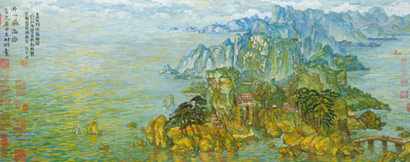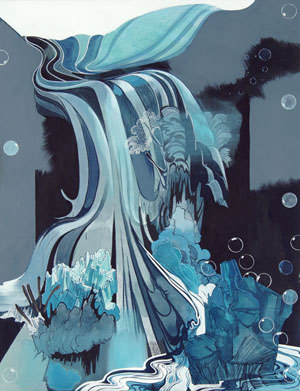Dragon Veins
January 13 – March 11, 2006
USF Contemporary Art Museum

Hongtu Zhang & Zhang Hongtu, Wang Meng-van Gogh #2, 2004
Friday, January 13
Idiosyncratic Hybrids: Traditional East Asian Art and Contemporary Painting
USF’s School of Art and Art History, new Assistant Professor (Fall 2006) will present a lecture exploring the earliest moment in Sino-European artistic and cultural interaction with emphasis on this famous Chinese painter’s relationship with Western art and science, and relates to the East-West theme of the Dragon Veins. Chin-sung Chang (Ph.D., Yale University 2004) is currently engaged in research related to a Post-Doctoral Fellowship at the Metropolitan Museum of Art in New York. Previously, Dr. Chang received two Masters’ degrees from Yale and another Master’s from Columbia University. His Bachelor’s degree is from Seoul National University, South Korea. A recipient of a Curatorial Fellowship and a Council on East Asian Studies Prize from Yale, his research works have been published in the U.S. and Korea. He has delivered research papers at international conferences in San Diego, Seattle, Boston and New York. His dissertation was “Mountains and Rivers, Pure and Splendid: Wang Hui (1632-1717) and the Making of LandscapePanoramas in Early Qing China”.
DOWNLOADS:
Exhibition Checklist

Susanne Kühn, Waterfall, 2002. Oil on canvas.
Dragon Veins surveys a variety of ways in which traditional East Asian art informs contemporary painting. In traditional Chinese art, dragon veins are the invisible threads or connectives which hold a painting together. As an exhibition title, it offers a metaphor for ways the artists idiosyncratically mine East Asian traditions of Chinese landscape painting, Buddhism, ukiyo-e, emaki, bunraku, nihon-ga and kazari, intermixing them with current political events, hip-hop culture, geological maps, modernist abstraction, bodily experience, Dr. Seuss, anime, Post-Impressionism and more. Artists include Frances Barth, David Brody, iona rozeal brown, Emily Cheng, Elisabeth Condon, Chie Fueki, Yun-Fei Ji, Susanne Kühn, Mernet Larsen, Sang Nam Lee, Takashi Murakami, and Zhang Hongtu. The exhibition also includes a new wall painting by David Brody, commissioned by USF CAM. Dragon Veins is organized by the USF Contemporary Art Museum, and curated by Elisabeth Condon and Mernet Larsen.
Dragon Veins Artists
Frances Barth merges the spatial hierarchies and mark making of Chinese landscape painting and Japanese scrolls with mapping, cross-sections and flatness to narrate "the story of a place over geological time.”
http://www.francesbarth.com
David Brody's depictive abstractions and geometric wall drawings draw upon Chinese painting to suggest ways of animating geometry and creating volume through the agglomeration of independent brush marks.
http://www.pierogi2000.com/flatfile/brodydav.html
iona rozeal brown bases her work on Japanese Ukiyo-e prints, commenting on the appropriation of Hip-Hop culture by Japanese youth.
http://carengoldenfineart.com
Emily Cheng fuses ancient Chinese Buddhist themes and symbols with ornamental traditions in exploring bodily experience through painting.
http://www.winstonwachter.com/artists/ny_cheng.html
http://www.emilycheng.com
Elisabeth Condon's idiosyncratic, gestural topographies, inspired by Yuan dynasty scrolls, playfully combine Dr. Seuss like mountains, the Florida landscape, and childhood memories through translucent fields of color.
http://www.elisabethcondon.com
Chie Fueki invests traditional Japanese decoration, symbolism and craft technique (kazari) with contemporary themes and approaches.
http://www.maryboonegallery.com
http://www.shoshanawayne.com
Zhang Hongtu lampoons the international "branding" of Chinese cultural history, playfully commingling recognizable images from both cultures. In this show, classic Chinese paintings are redone in the manner of French Post-Impressionists.
http://www.momao.com
Yun-Fei Ji uses traditional Chinese literati methods to portray current political situations occurring in China, such as the effects of the construction of the Three Gorges dam.
http://www.jamescohan.com
Susanne Kühn's lush, vibrant forests, reflect her interest in traditions such as German Romanticism, Expressionism, Chinese landscape painting, and Eastern and Western woodcuts.
http://www.goffandrosenthal.com
Mernet Larsen’s recent figurative work reflects her engagement with Japanese Bunraku theatre (via the ideas of Roland Barthes )and 12th c. Japanese narrative painting.
http://www.nyss.org/larsen/index.htm
Sang Nam Lee’s highly conceptual, spare paintings merge Duchampian aesthetics and ancient Buddhist thought.
http://www.elgawimmer.com
Takashi Murakami holds a doctorate in the traditional Japanese nihon-ga painting style, to which he adds contemporary Japanese cartoons techniques, such as anime.
http://www.marianneboeskygallery.com/artist/takashimurakami/index.html
This exhibition is made possible by the Members and Corporate Partners of USFCAM, and Sponsored by Central Florida Eurocars
Project Sponsor
